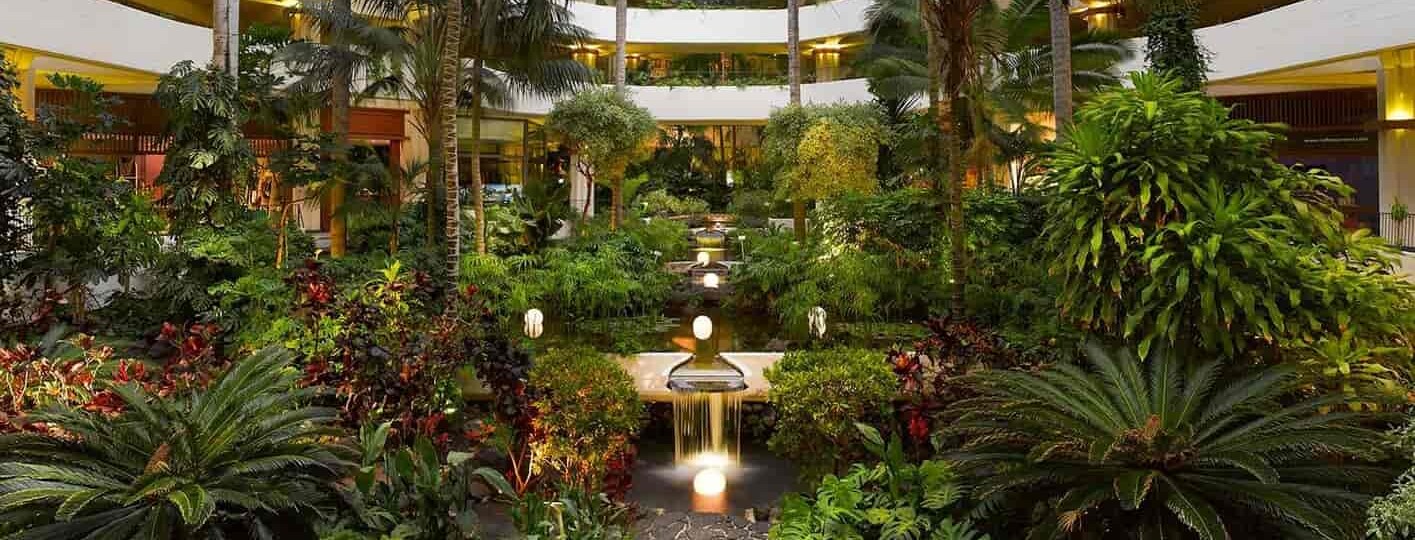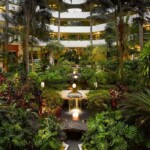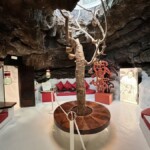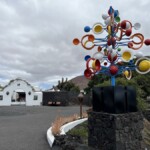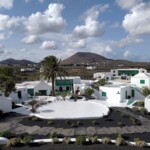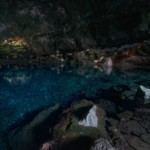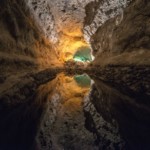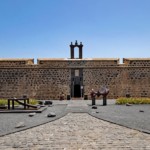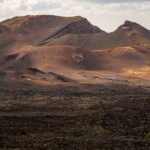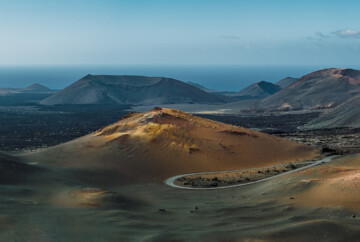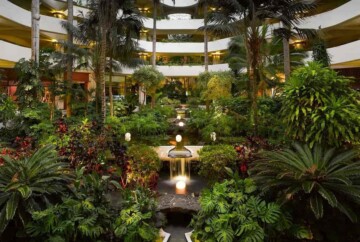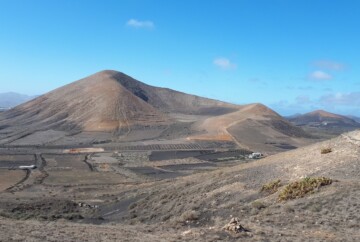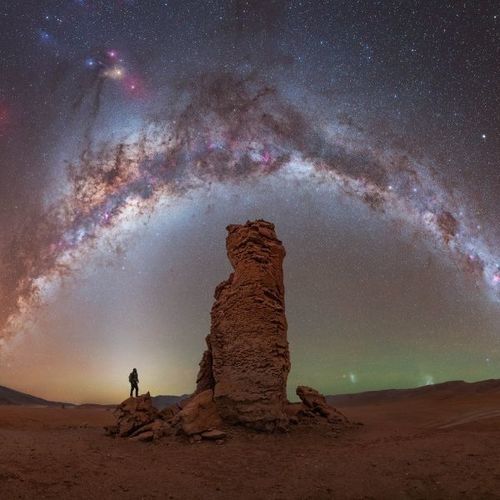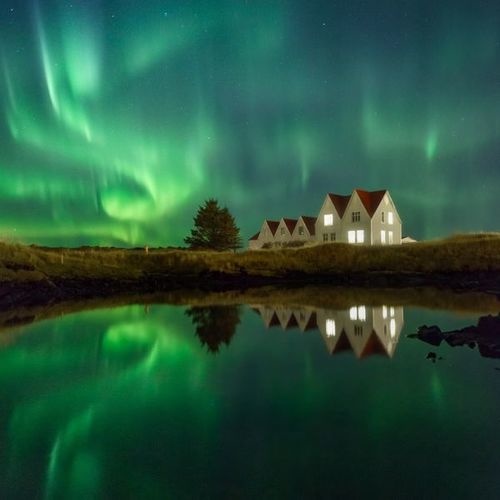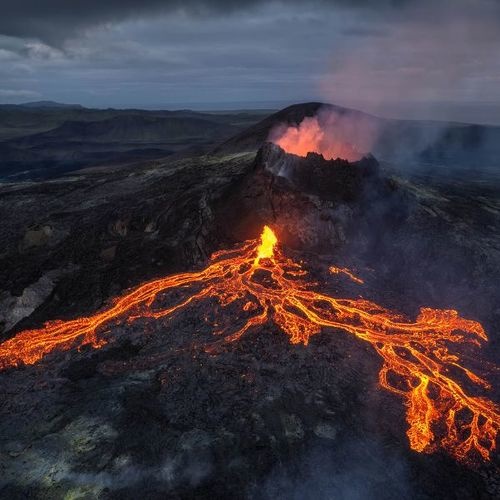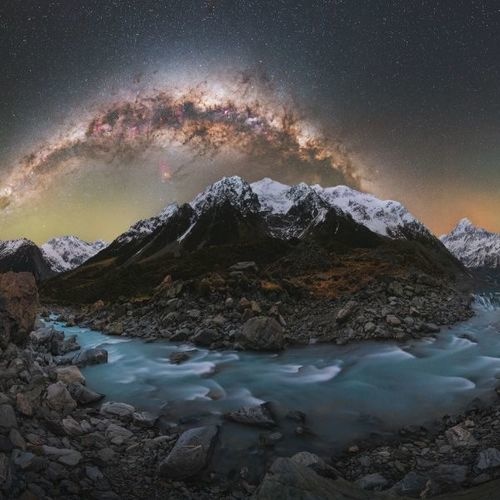Exploring the works of César Manrique in Lanzarote is an essential part of any trip to the island. This Canarian artist has left an indelible mark on the Island of Volcanoes through his paintings, sculptures, murals, and architectural marvels.
What truly distinguishes Manrique’s creations from the Lanzarote landscape is the seamless blend of art and ecology, a concept that was remarkably avant-garde during his time. In each of César Manrique’s Lanzarote creations, you’ll witness the profound connection between nature and humanity, with the natural environment serving as a fundamental element in his works.
While Jameos del Agua and Cueva de los Verdes are some of the most popular attractions in Lanzarote, there are more hidden gems created by César Manrique that deserve your attention.
If you prefer not to drive, you can also opt for one of the excursions in Lanzarote that include visits to these sites. For instance, we joined this tour during our three-day trip to Lanzarote, which included the awe-inspiring Timanfaya National Park, one of the best places to visit in Spain. The tour was very well-organized, which gave us enough time to fully appreciate each location. However, if you want to delve deeper into Manrique’s life and work, I highly recommend this excursion.
The importance of César Manrique’s works in Lanzarote
The impact of César Manrique in Lanzarote is undeniable. Born in 1919, his artistic legacy primarily graces Lanzarote, but his influence can be felt in the neighboring Canary Islands of Tenerife, Fuerteventura, La Gomera, and El Hierro. Yet, his heart was forever captivated by the Island of the Volcanoes.
His special connection with Lanzarote goes back to his childhood in Arrecife, where he lived with his family. He joyfully spent his summers at his beachfront home in Caleta de Famara. In the rugged, volcanic landscape that some might see as harsh and unwelcoming, Manrique saw “the most beautiful place in the world.” He envisioned it as a canvas for his art, a realm awaiting his touch to amplify its natural beauty.
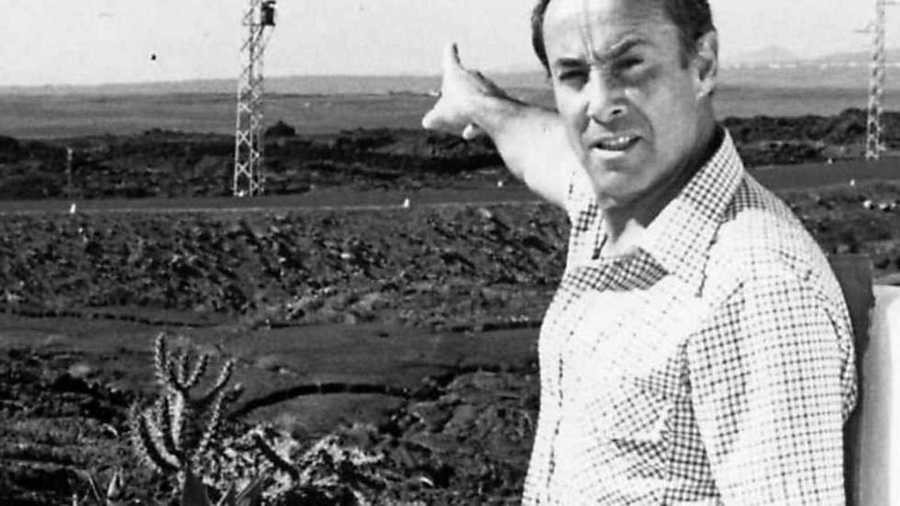
The importance of César Manrique’s works in Lanzarote
In 1968, after years of exploring Europe and the United States, César Manrique returned to Lanzarote. He was met with an unprecedented tourism boom, and he recognized the need for transformative projects. These initiatives would not only reshape the island’s identity but also conserve its distinctive landscapes, something that was threatened by the rapid proliferation of sprawling hotel complexes. In the midst of some protests, Manrique’s works were carried out with a key focus on preserving the island’s ecosystems and safeguarding its pristine natural environments.
He contributed to the construction of viewpoints, gardens, and sculptures, as well as the restoration of traditional Canarian architecture and abandoned spaces for tourism. Each transformation retained the essence of its original form, infused with a modern twist. In 1992, César Manrique passed away in Teguise, but his legacy, both as an artist and protector of local customs and native landscapes, lives on.
1. Jameos del Agua, one of the best works of César Manrique in Lanzarote
Jameos del Agua is undeniably one of the standout tourist attractions created by César Manrique in Haría, Lanzarote. As the first Art, Culture, and Tourism Center on the island, it offers an extraordinary artistic experience, beautifully combining the natural and human worlds.
After the volcanic eruptions of the Corona Volcano, one of the most important volcanoes in Lanzarote, water gradually seeped through the lava flows and the earth, forming a large underground cavity with a picturesque lagoon within it. Jameos del Agua emerged within this volcanic tube—a unique auditorium hosting concerts and events, complete with a restaurant where you can enjoy the finest Mediterranean and Spanish dishes before or after the shows.

1. Jameos del Agua, one of the best works of César Manrique in Lanzarote
This enchanting attraction is also home to one of the most exceptional species of albino crabs known as “jameitos.” The ingenious work of César Manrique ensured that this captivating landscape was fully appreciated while preserving the delicate ecosystem that thrives here.
For further insights, you can also explore the Volcano House Museum by César Manrique in Lanzarote, located outside the lava tube. There, you will find exhibits about the volcanic tube’s formation and the project’s origins. You can also visit the palm garden and its artificial lake.
- Hours: Open daily from 10:00 a.m. to 5:15 p.m.
- Admission: The ticket price is €14, which you can book through this link.
- Location: Haría
2. Cueva de los Verdes, another impressive creation of César Manrique
No itinerary would be complete without a visit to Cueva de los Verdes—another awe-inspiring work by César Manrique in Haría, Lanzarote. Cueva de los Verdes is located just a few steps away from Jameos del Agua, so you can explore both in a single day.
This attraction is an integral part of the same network of volcanic tunnels stemming from the Corona Volcano. However, unlike Jameos del Agua, Cueva de los Verdes provides a unique opportunity to appreciate the untouched beauty of this volcanic wonder.
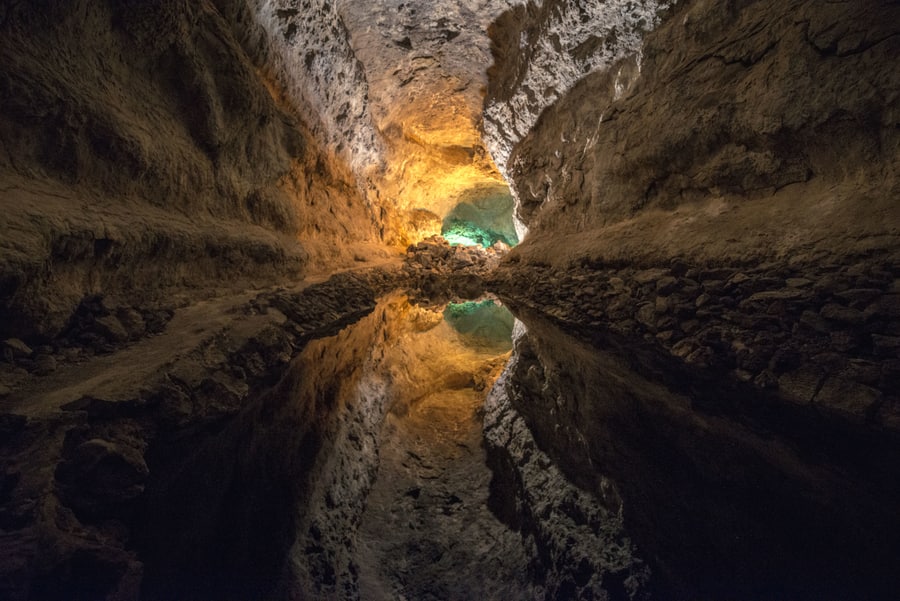
2. Cueva de los Verdes, another impressive creation of César Manrique
In this case, the site has been adapted to allow people to visit. However, it still preserves many of its natural characteristics. You’ll traverse approximately 0.6 miles of this nearly 5-mile-long cave, all while enjoying the ambiance of perfectly harmonized lighting and sound.
Observing the interior vaults and lagoons up close is a truly breathtaking experience, with some areas reaching staggering heights of up to 165 feet. Plus, it has been said that this cave was a refuge for island residents during pirate attacks in the 17th century, which adds a fascinating historical dimension to this place.
- Hours: Open daily from 10:00 a.m. to 5:00 p.m.
- Admission: €10 for adults, and €5 for kids.
- Location: Haría
3. Mirador del Río, one of César Manrique’s works with panoramic views
Mirador del Río is another iconic work of the acclaimed Lanzarote artist César Manrique. This popular tourist attraction offers breathtaking panoramic views on the island and is just a short 15-minute drive from Cueva de los Verdes. It’s a must-visit spot, so don’t miss it!
Mirador del Río was built at the top of the highest point of the Risco de Famara at 1,500 feet above sea level. If you visit on a clear day, you’ll be treated to stunning views that extend all the way to the neighboring island of La Graciosa and other islands of the Chinijo Archipelago, forming Europe’s largest marine reserve. Other places you will see from there are the Salinas, Clara Mountain, Caleta de Famara, and Alegranza.
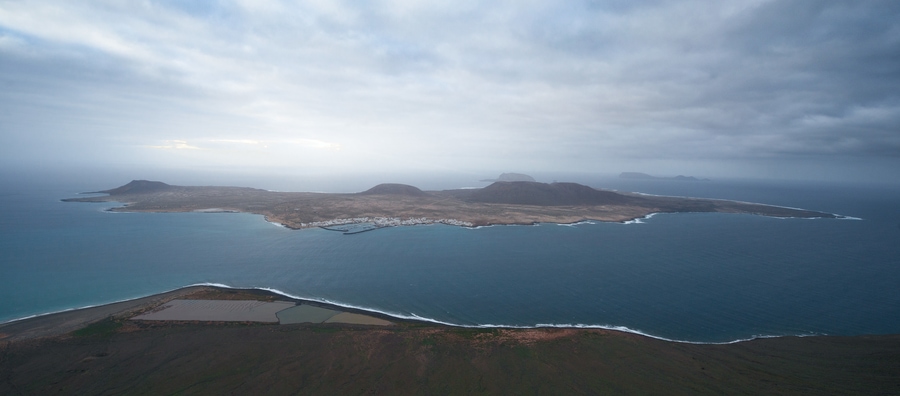
3. Mirador del Río, one of César Manrique’s works with panoramic views
When it’s a bit cooler, I recommend bringing some warm layers to wear because the higher altitudes can get chilly, and the winds can be quite brisk. But don’t let that stop you! It would be a shame to miss the chance to see Lanzarote from this unique perspective, where the sea and sky blend on the horizon. The volcanic landscapes, with their warm ocher and beige tones and gentle curves, are a real treat, especially during sunset.
If you want to complement your visit with some interesting facts about the brilliant works of César Manrique in Lanzarote, you’ve come to the right place. Mirador del Río offers informative panels with historical and architectural insights, as well as telescopes for a closer look. Families with kids will appreciate the outdoor play areas, and there’s also a charming café serving simple sandwiches if you need a snack.
- Hours: Open daily from 10:00 a.m. to 4:40 p.m.
- Admission: €5 for adults, and €2.50 for kids.
- Location: Orzola
4. Cactus Garden, one of the most popular works of César Manrique
Continuing your exploration of the greatest works of César Manrique in Lanzarote, the Cactus Garden is another place you won’t want to miss. Plus, if you want to make the most of your time, the Cactus Garden is close to several other attractions. More specifically, it’s located about 15 minutes by car from Villa de Teguise, the former capital of the island, and just 5 minutes from the charming town of Charco del Palo, where you can enjoy some of the best natural pools in Lanzarote.
César Manrique’s Jardin de Cactus is home to a remarkable collection of 10,000 cacti specimens representing over 1,400 different species from various corners of the world. To fully appreciate this unique place, you can embark on a tour along the network of cobblestone paths that intricately weave through the expansive 54,000 square feet of the park.
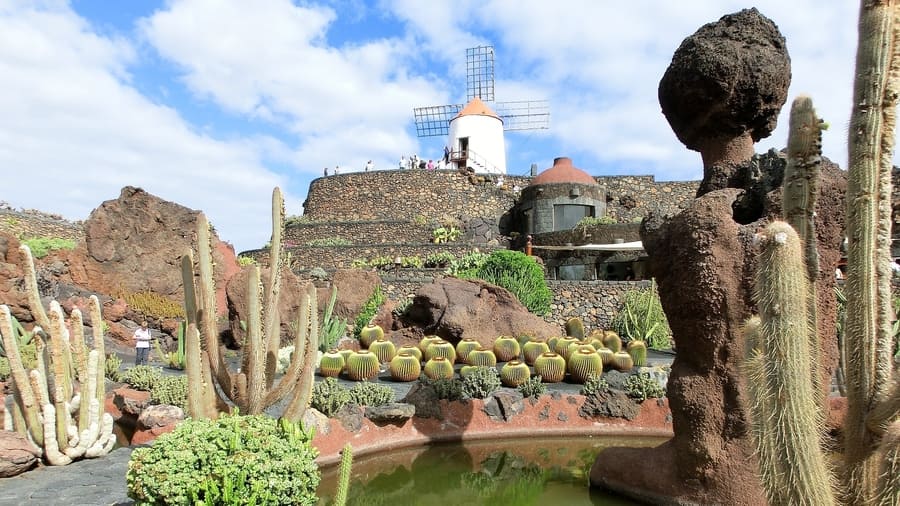
4. Cactus Garden, one of the most popular works of César Manrique
This garden was built on an old volcanic sand quarry, which once served as an area for cultivation by local farmers. It’s a brilliant example of how Manrique’s projects aimed to rehabilitate landscapes and integrate them into their natural surroundings. Notable features of this beautiful garden include well-preserved old mills and a striking 26-foot-tall giant cactus statue that welcomes you at the entrance.
After your visit, which will take around 90 minutes, I recommend stopping by the garden’s cafeteria. While sipping a warm coffee or enjoying a light snack, you can admire another captivating work of César Manrique in Lanzarote: the mural located inside.
- Hours: Open daily from 10:00 a.m. to 4:30 p.m.
- Admission: €6.50 for adults, €3.25 for kids.
- Location: Guatiza
5. Castillo de San José, one of the works of César Manrique in Arrecife, Lanzarote
The Castillo de San José is not just another entry in the portfolio of César Manrique; it’s also one of the must-see attractions in Arrecife. While you can explore it independently, I highly recommend joining this guided tour to make the most of your visit and discover other treasures in the town’s historic center, such as Charco de San Ginés and Puente de las Bolas.
While this fortress was built in the 18th century, it remains intact to this day. César Manrique carried out a project to revamp the structure and inaugurated the prestigious International Museum of Contemporary Art.
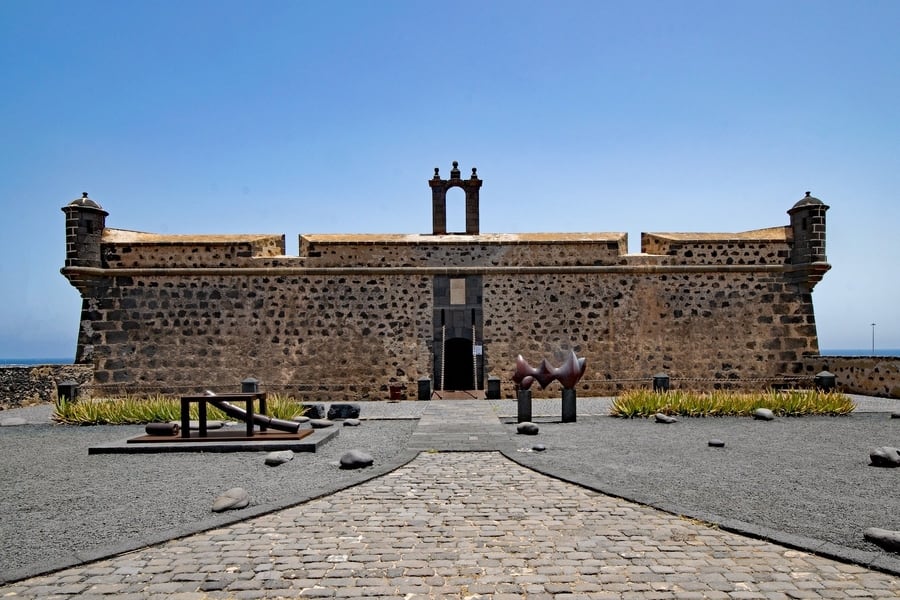
5. Castillo de San José, one of the works of César Manrique in Arrecife, Lanzarote
This is the first contemporary art museum in the Canary Islands, housing an impressive collection featuring works by renowned artists like Joan Miró and Pablo Picasso, along with contributions from international, national, and local talents. The museum hosts temporary exhibitions and cultural activities, so make sure to check their program and choose a time that fits your schedule.
After your tour, I recommend visiting the restaurant on the ground floor of the Castle, which serves a tasting menu accompanied by a selection of the finest wines from La Geria. Alternatively, you can simply sit there and enjoy the breathtaking panoramic views of the entire bay and Puerto de Naos.
- Hours: Open daily from 11:00 a.m. to 6:00 p.m.
- Admission: €4 for adults, €2 for kids.
- Location: Arrecife
6. Casa-Museo del Campesino and the Monument to Fertility, two of the most traditional works by César Manrique
The Casa-Museo del Campesino (Farmer’s House Museum) is another creation of César Manrique in Lanzarote. It pays homage to Canarian customs and traditions by honoring the hardworking farmers who cultivated the island’s challenging volcanic land.
The best part is that this architectural complex is free to visit and allows you to learn about various aspects of island life, from architecture to crafts, agriculture, and delicious Canarian gastronomy. Within this complex, you’ll witness one of Manrique’s most standout works: the Monument to Fertility, a remarkable structure standing over 50 feet tall. It’s created from different waste elements that were commonly used in ancient times, such as ship water tanks, iron pieces, and concrete. It is the true symbol of the island that you shouldn’t miss.
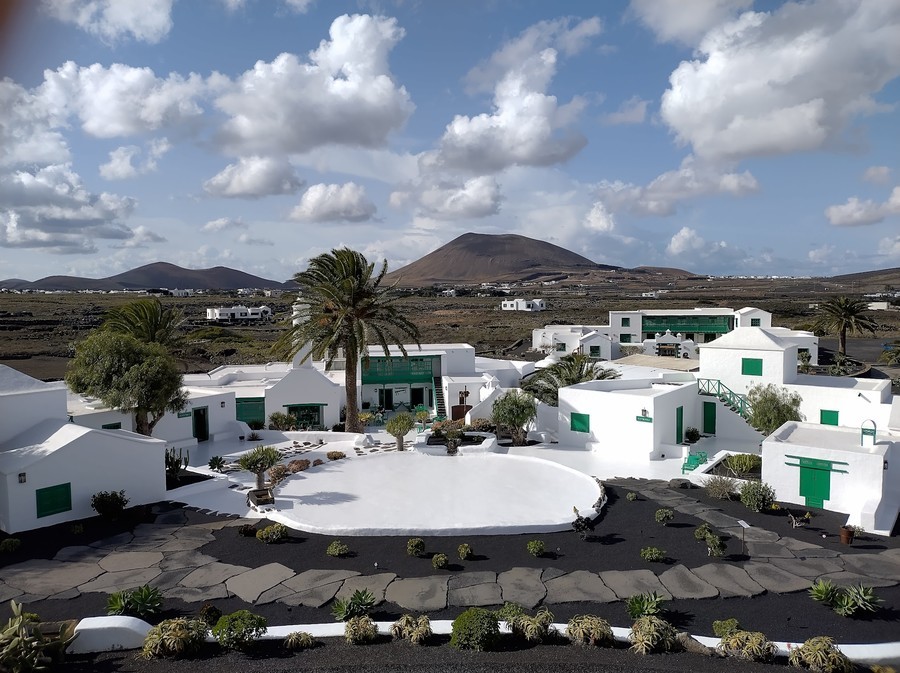
6. Casa-Museo del Campesino and the Monument to Fertility, two of the most traditional works by César Manrique
As you continue your visit, follow the main path to discover exhibitions of farming tools, camel saddles, and various implements that were essential for manual labor. Then, head to the Plaza de los Artesanos, where you can participate in classes designed to showcase traditional crafts and techniques like weaving, hat making, and leatherwork. I assure you that it will be a great, enjoyable activity for the whole family, including the little ones.
The museum also has a restaurant, but you must reserve your table at least 2 hours before your visit. The restaurant is open from 12:00 p.m. to 4:00 p.m. and is renowned for its selection of exquisite artisanal cheeses.
- Hours: Open daily day from 10:00 a.m. to 6:00 p.m.
- Admission: Free
- Location: Mozaga
7. Taro de Tahíche – Case del Volcán, the headquarters of the César Manrique Foundation in Lanzarote
Taro de Tahíche was once César Manrique’s house in Lanzarote, where he lived for 20 years after spending some time in the United States. Today, it houses the César Manrique Foundation, making it one of the most important places regarding the life and work of the Canarian artist.
The story of this place traces back to a time when Manrique discovered an ancient taro, a type of structure used as a shelter by shepherds. While others might have seen only ruins, Manrique saw an opportunity to create his home. To preserve the traditional architectural aspects of the building, he decided to integrate it with the natural surroundings. His final plan included a lava flow featuring five volcanic bubbles, with each bubble transformed into a separate room.
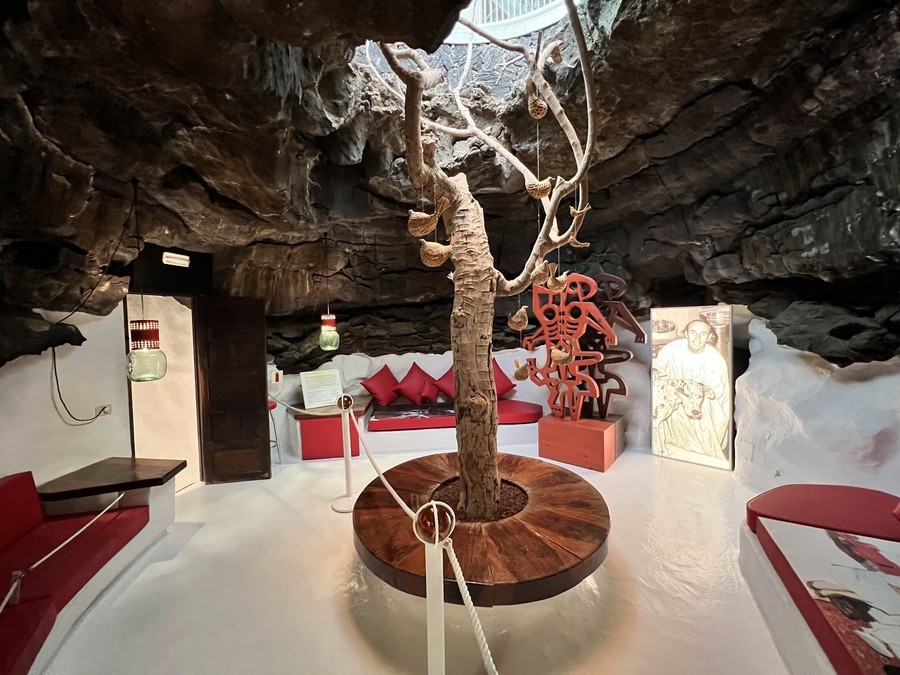
7. Taro de Tahíche – Case del Volcán, the headquarters of the César Manrique Foundation in Lanzarote
As a result, the Casa del Volcán, as it’s popularly known, stands today with its white walls and a design that blends with the natural environment. The César Manrique House in Lanzarote even features a recreation area and a swimming pool.
Inside, you’ll find a plethora of Manrique’s personal belongings, a collection of his private works, and a selection of some of the most iconic sculptures he created in Lanzarote. One standout piece is the Buried Coccyx canvas, a work featuring animal fossils and volcanic flow inlays painted using natural pigments sourced from Lanzarote’s volcanic soil.
- Hours: Open daily from 10:00 a.m. to 6:00 p.m.
- Admission: €10 for adults, €3 for children. Consider getting a combined ticket for both Taro de Tahíche and Casa del Palmeral (€17 for adults and €4 for children).
- Location: Tahíche
8. César Manrique House Museum – Casa del Palmeral, another one of César Manrique’s houses in Lanzarote
The César Manrique House Museum in Lanzarote, also known as the Palm Grove House, offers a profound immersion into the artist’s life and work. This enchanting museum is located amidst the lush palm groves of Haría, one of the most verdant landscapes in the north of the island—an oasis of greenery that served as the backdrop for the artist’s final years until his passing. This makes it one of the most important places to delve into César Manrique’s journey through Lanzarote.
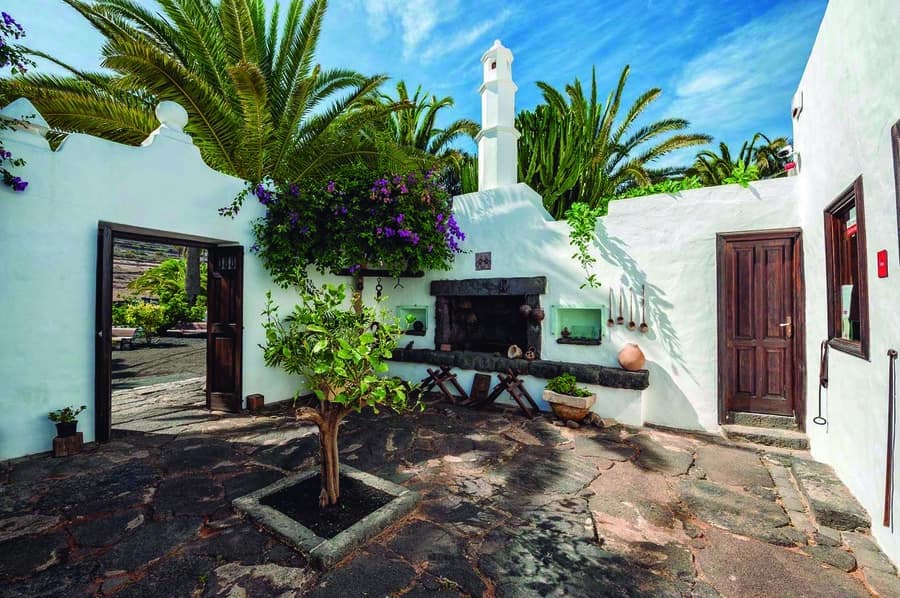
8. César Manrique House Museum – Casa del Palmeral, another one of César Manrique’s houses in Lanzarote
The Casa del Palmeral project began in the late 1980s when Manrique decided to breathe new life into the ruins of a house on his agricultural property. True to the island’s traditional architectural style, the renovation resulted in a charming space featuring various rooms, two inviting patios, and a workshop where Manrique conceived some of his most renowned works, including the iconic Jameos del Agua.
Since opening its doors to the public in 2013, the César Manrique House Museum in Lanzarote offers a poignant window into Manrique’s world. Exhibitions within the museum showcase his personal belongings, artistic tools, and handcrafted pieces. The preserved workshop, adorned with some of Manrique’s unfinished paintings, stands as a testament to his creative journey, frozen in time.
- Hours: Open daily from 10:30 a.m. to 6:00 p.m.
- Admission: €10 for adults, €3 for children, or you can opt for a combined ticket with Taro de Tahíche (€17 for adults and €4 for children).
- Location: Haría
9. Timanfaya National Park, another significant work of César Manrique in Lanzarote
Timanfaya National Park is one of the most incredible national parks in Spain and a must-see near Yaiza, Lanzarote. This protected area of 70 square miles is home to the Fire Mountains, a set of 25 craters that were formed in the 18th and 19th centuries, surrounded by lunar landscapes that will leave you in awe.
Manrique was not only involved in creating the concept that gave rise to the sculpture that is today the emblem of the park, El Diablo de Timanfaya, but he also participated in the development of the Ruta de Los Volcanes, a project that allowed the delicate landscapes of the Timanfaya volcano to be protected and at the same time making them very accessible to visitors. Through a system of guided buses that circulate along a carefully laid out road, access to the deepest part of this volcanic landscape was allowed, minimizing the impact on the environment.

9. Timanfaya National Park, another significant work of César Manrique in Lanzarote
Another notable work of César Manrique in Lanzarote is the El Diablo Restaurant, located inside the park, showcasing yet another facet of Manrique’s brilliance. This restaurant is more than a place to eat in Lanzarote; it’s a gastronomic haven where the natural heat from the earth, reaching temperatures of almost 500°F at a depth of 30 feet below the surface, is ingeniously harnessed to cook exquisite dishes over embers. This culinary experience is complemented by the restaurant’s stunning structure, a testament to Manrique’s creative architectural style, with nature always taking center stage.
- Hours: Open daily from 12:00 p.m. to 3:45 p.m.
- Admission: Free
- Location: Yaiza
10. Garden of the Gran Meliá Salinas Hotel, one of the oldest works of César Manrique
The Gran Meliá Salinas Hotel, now known as Paradisus Salinas Lanzarote, stands out as one of the first hotels in Costa Teguise. Today, the resort is recognized as one of the best 5-star hotels in Lanzarote. Renowned for its timeless elegance and top-notch amenities, the Paradisus Salinas is also home to another enduring masterpiece by Manrique – the stunning Gran Melia Salinas Garden.
These gardens, celebrated as the Artistic and Cultural Heritage of Lanzarote, offer a captivating oasis of palm trees. Visiting this hotel garden by César Manrique in Lanzarote is one of the best things to do in Costa Teguise, promising relaxation amidst lush vegetation.
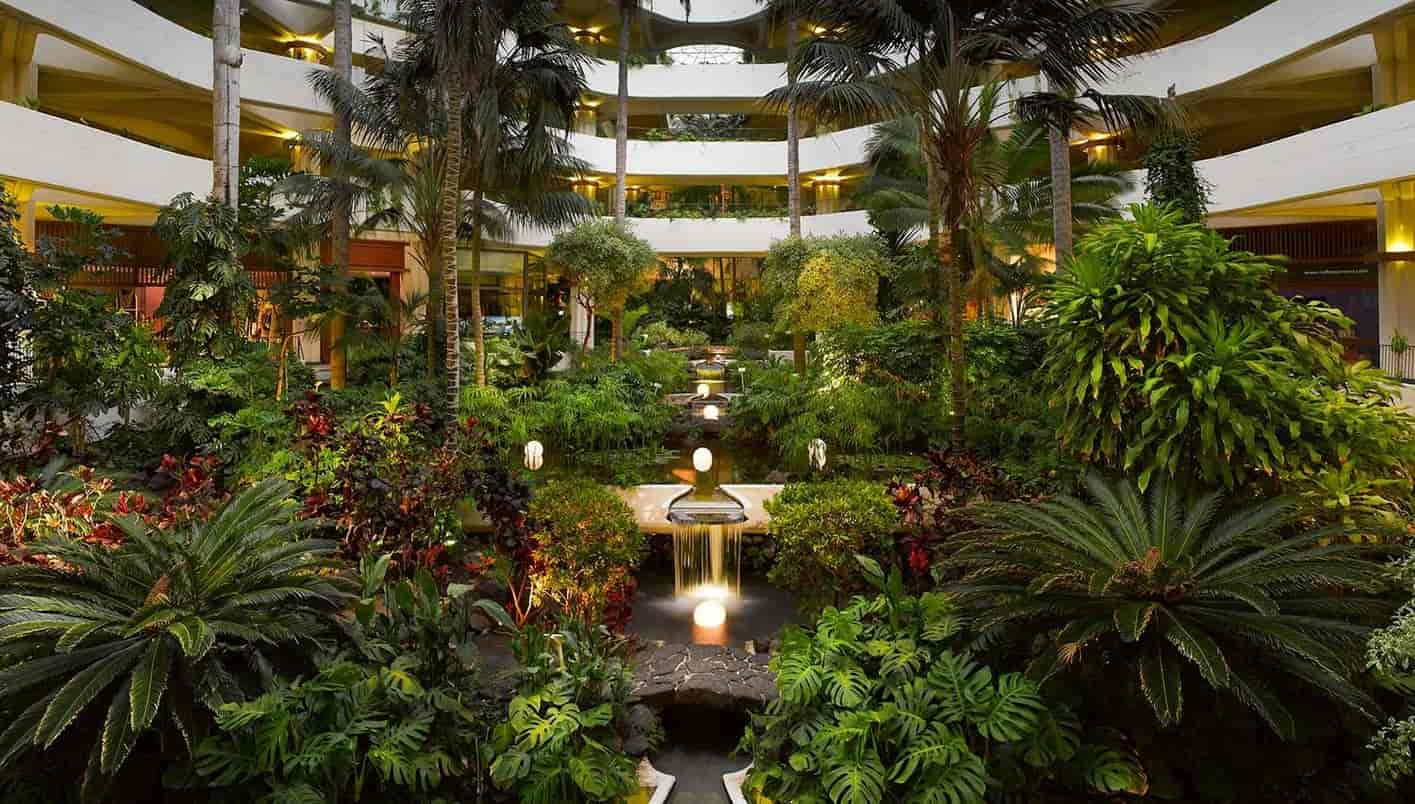
10. Garden of the Gran Meliá Salinas Hotel, one of the oldest works of César Manrique
Inside the hotel, you’ll also find two captivating murals crafted by César Manrique using black basaltic lava and plaster. Moreover, the hotel is located in front of one of the most popular beaches in Costa Teguise, making it an ideal destination to visit even after a relaxing day under the sun. Remember that the surroundings are full of attractions, including diverse murals, a grand artificial lagoon, and magnificent waterfalls.
- Admission: Free
- Location: Costa Teguise
10+1 Wind Toys by César Manrique in Lanzarote
César Manrique’s Wind Toys (Juguetes del Viento) is my favorite piece by the artist. This collection of over 10 imaginative sculptures is one of his most beloved works and is scattered across Lanzarote and other Canary Islands. These whimsical windmills, featuring original structures and vibrant colors, showcase the creative brilliance of the artist. Families can enjoy a playful adventure by spotting these iconic sculptures while exploring the islands.
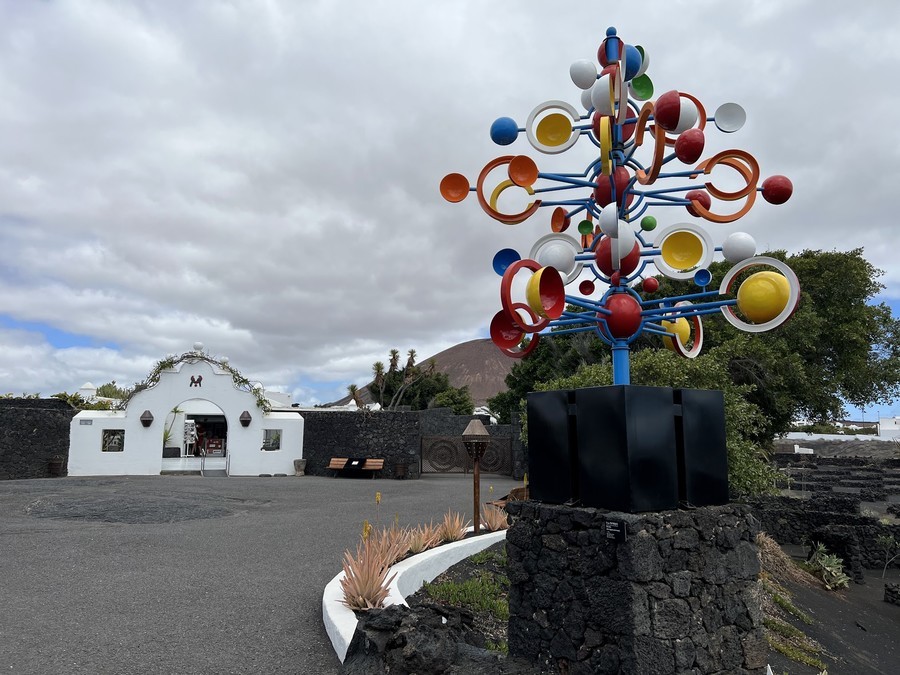
10+1 Wind Toys by César Manrique in Lanzarote
Nature itself plays a role in bringing these sculptures to life when the wind gracefully interacts with each creation. Take, for instance, the renowned Fobos, an elegant stainless steel structure welcoming visitors at the entrance roundabout to the César Manrique Foundation in Lanzarote. Another charming wind toy, Róbalo, is located on Avenida de Las Playas in Puerto del Carmen, just a stone’s throw away from the beautiful Los Pocillos Beach.
While these enchanting windmills can be found in remote villages like San Bartolomé and Arrieta, you’ll also discover them in tourist hotspots such as the Lanzarote Airport, Playa Blanca, and even at the entrance to the Cactus Garden. What makes this project even more remarkable is that, even after César Manrique’s passing, these sculptures endure, brought to life from the artist’s original sketches.
Map of works by César Manrique in Lanzarote
For your convenience, I’ve provided a map showing the locations of César Manrique’s works in Lanzarote that I mentioned earlier. Feel free to download it for reference while traveling around the island:
Additionally, if you’re planning to explore other attractions on the island, you can consult our tourist map of Lanzarote for a well-rounded itinerary.
Other works by César Manrique in the Canary Islands
César Manrique’s influence extends beyond Lanzarote, reaching other Canary Islands with notable works. So, if you are traveling through the other islands, there are a few places you won’t want to miss.
Lago Martiánez, located in Puerto de la Cruz, Tenerife, stands out as one of César Manrique’s most significant works outside of Lanzarote, and one of the must-see attractions in Tenerife. This artificial lagoon, resembling an emerald, features five islands with gardens, sculptures, restaurants, and terraces offering stunning views of Mount Teide, the highest peak in the Canary Islands.
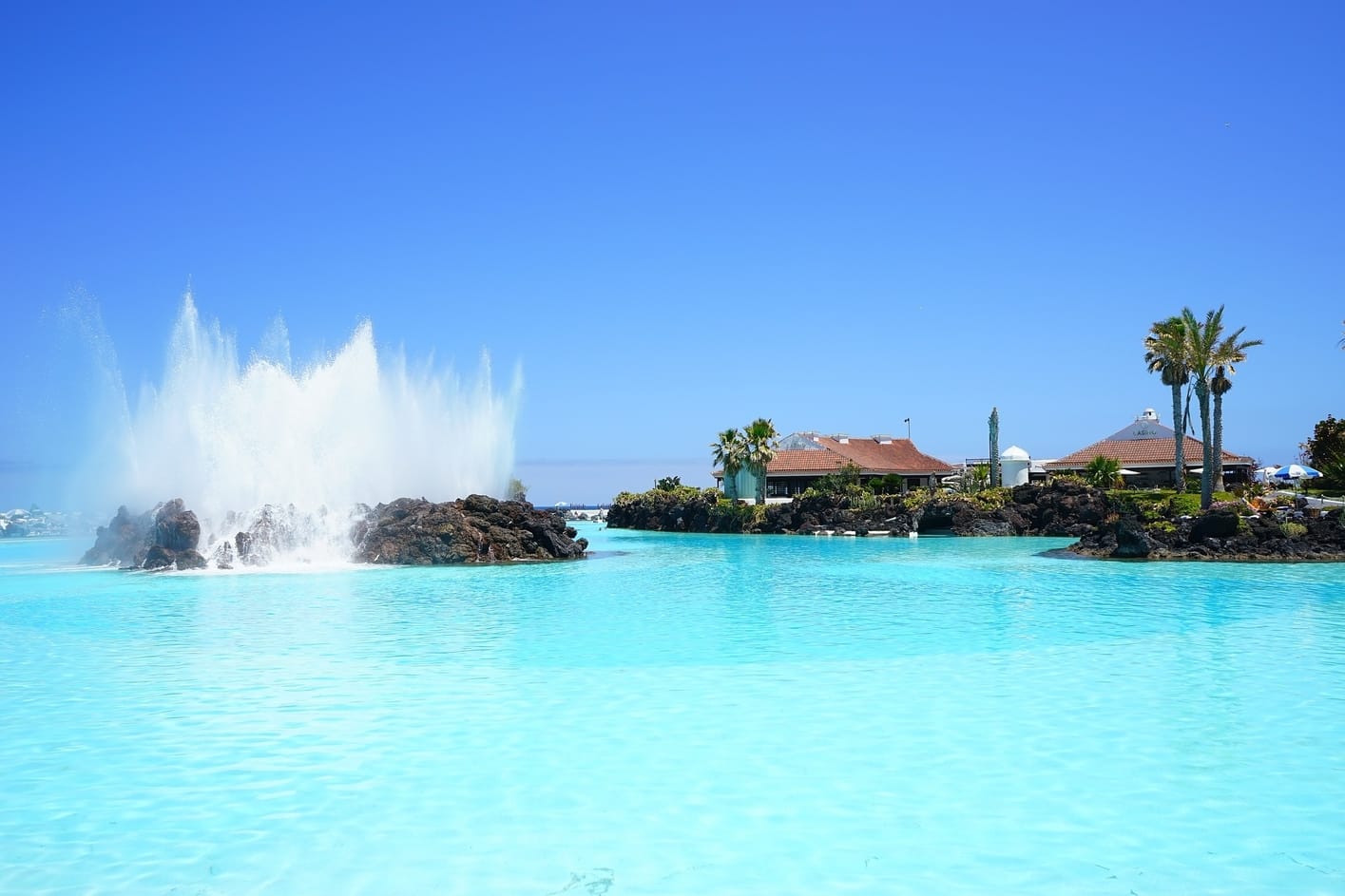
Other works by César Manrique in the Canary Islands
In Tenerife, you will also find the César Manrique Maritime Park in Santa Cruz de Tenerife, a posthumous collaboration with architect Santiago Calatrava, reflecting the indisputable brilliance of both artists.
The Mirador de El Palmarejo in La Gomera, and the Mirador de Peña in El Hierro, are two more picturesque creations designed by César Manrique.
Furthermore, you can find Wind Toys by César Manrique across various Canary Islands, with Phobos in Fuerteventura being among the most popular.
And that concludes our comprehensive guide on César Manrique’s works across the Canary Islands. I hope this guide assists you in choosing your destinations on the island. If you have questions or wish to share your experience discovering the artistic works of César Manrique in Lanzarote, feel free to leave a comment below. I’d be delighted to hear from you!
May your journey be filled with the joy of discovering César Manrique’s legacy!
